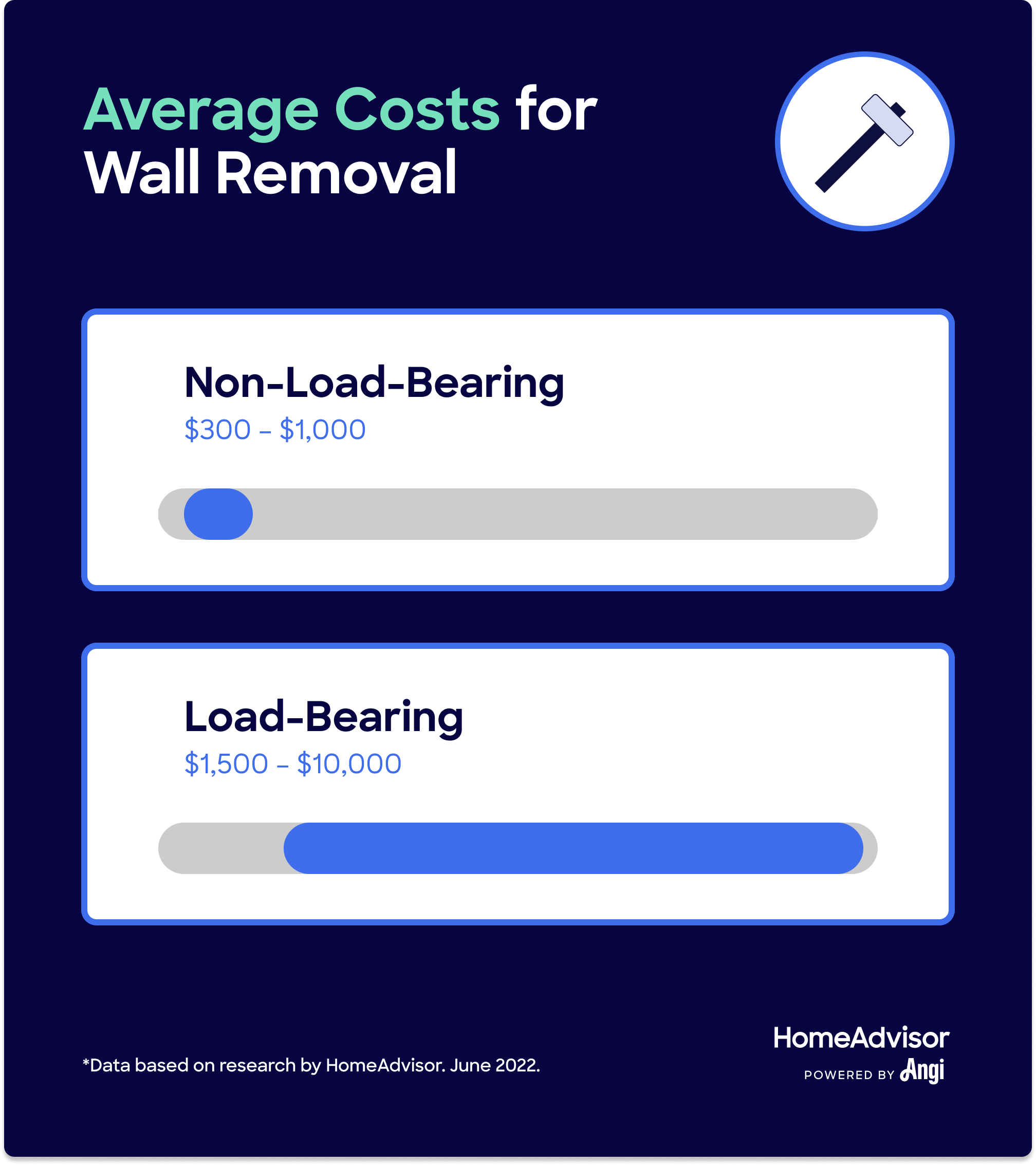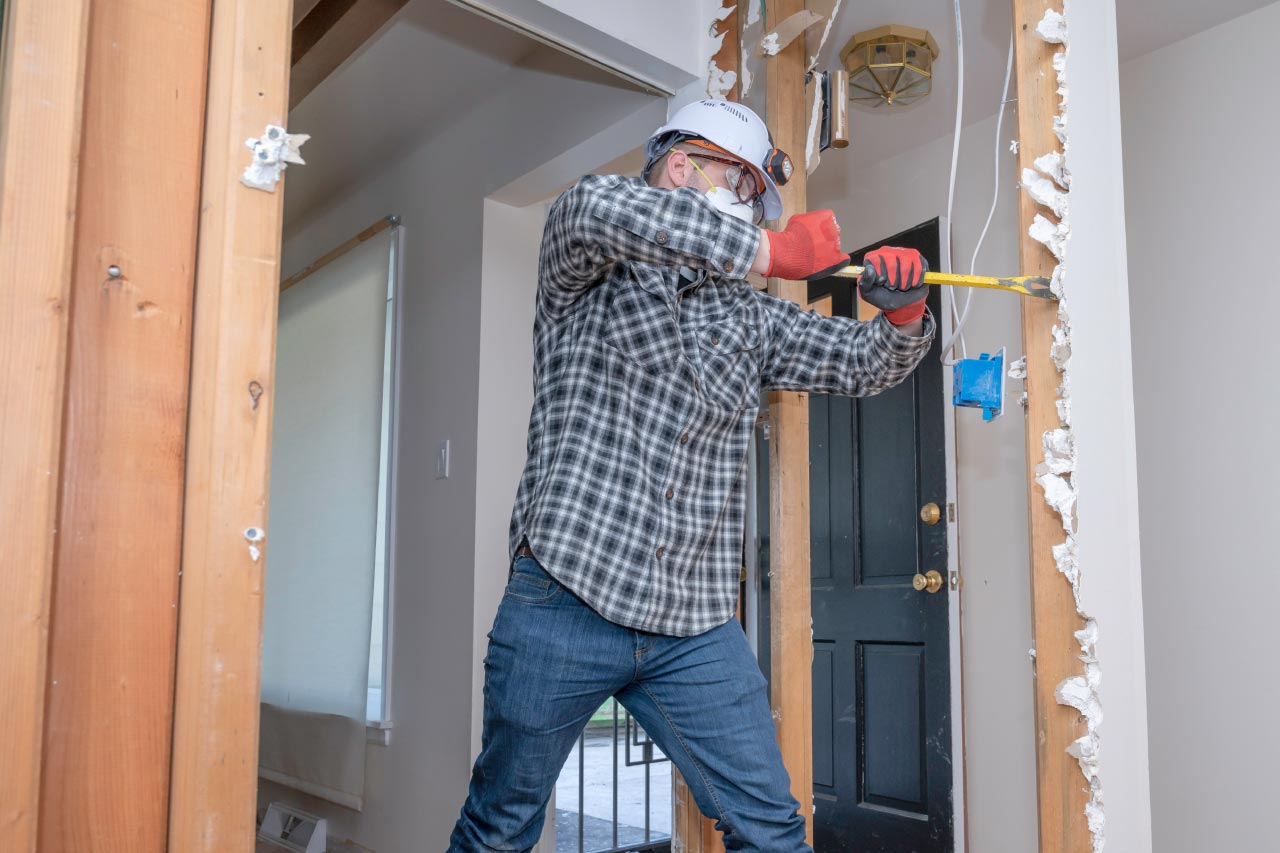How Much Does It Cost to Remove a Wall?
Typical Range:
$300 - $10,000
Typical Range:
$300 - $10,000
Cost data is based on research by HomeAdvisor.
Updated April 15, 2024
Reviewed by Cati O'Keefe, Expert Home Building & Sustainability Contributor.Removing a load-bearing wall requires professional expertise to ensure the home remains structurally sound.
The project costs for removing a load-bearing wall range from $1,200 to $10,000.
Cost factors include project size and scope, type of beam used, labor, and potential plumbing and electrical adjustments.
Popular materials for support beams include laminated veneer lumber and steel.
Warning signs for beam replacement include sticking doors, saggy ceilings, unlevel floors, and structural instability.
The project enhances floor plan openness, accommodates larger possessions, increases resale value, and attracts potential buyers.
Highlights were summarized from this existing cost guide text using automation technology and were thoroughly reviewed for accuracy by HomeAdvisor Editor Ryan Noonan.
Removing a wall costs between $300 and $1,000 if it is a non-load-bearing wall. On the other hand, removing a load-bearing wall costs $1,200 to $3,000 for a single-story home. The price increases to $3,200 to $10,000 for homes with more than one level.
Even when they are not load-bearing, walls are important to the structure of your home. They can house electrical, plumbing, and other service lines. Therefore, you should always consult a professional structural engineer to ensure the removal will not put your home’s structural integrity at risk. Similarly, a licensed and experienced contractor should perform the work.
If you're removing a load-bearing wall in a home with a single level, project costs will range from $1,200 to $3,000. For multi-level homes, expect to pay between $3,200 and $10,000. Exact prices will depend on the size and project scope.
Homeowners may choose to invest in this costly and time-consuming project for any number of reasons, including:
Create a more open floor plan in an older home
Make room for larger possessions, like big-screen televisions and furniture
Increase resale value
Appeal to potential buyers
Costs to install a steel beam range from $1,300 to $5,000, but will vary based on the size and type of steel beam you choose and the labor needed to install it. The more popular and cost-effective option, laminated veneer lumber (LVL) beams, ranges in price from $55 to $400 each, not including installation.
You cannot remove a load-bearing wall without installing an alternative support structure in its place. A professional should always size and install your beam. Improperly-installed support beams can lead to sticking doors and windows, saggy or cracked ceilings, and unlevel floors. More importantly, your home will no longer be structurally sound, and could even collapse.
Creating a half wall or pass-through can open space between living areas. Even though you're only removing a portion of the wall, you should still consult a pro to ensure it's done properly.
On average, homeowners pay $300 to $1,000 to remove a non-load-bearing wall. Cost factors to consider include size of the job, number of service lines a pro must move and site conditions.
You will not need a support structure, but you should still consult a professional, even if you intend to do the work yourself.
All exterior walls of a home are load-bearing. Because they have settled with the home since its construction, removing this support structure could damage the home in ways an interior one would not. As a result, exterior walls are rarely removed.
When building an addition, pros usually leave the exterior structure in place and install a doorway for egress. A pro can refinish the exterior wall to match the rest of the interior, or leave it as is.
"If you plan to remove a wall that houses a waste stack or multiple services that will be expensive to reroute, ask your contractor or architect for alternatives to removal, such as switching room functions or using half walls, pass-throughs and arched doorways that leave some wall space intact."
Cati O'Keefe, Expert Home Building & Sustainability Contributor.
The price to take down a wall depends on the number and type of services housed within, like electrical lines or plumbing pipes. You can hire individual contractors to move each service or you can hire a general contractor to coordinate the entire project.
Using a general contractor will cost more overall, but will save you time in locating, hiring and managing multiple tradespeople.
The average cost to hire a plumber ranges from $45 to $200 per hour, depending on the job, timing, and location. Exact project rates will vary based on the number and type of pipes that they must remove, replace or relocate.
The price to hire an electrician is between $50 and $100 per hour, depending on experience and license type. Total cost will depend on project complexity. Many electricians also charge a one- to two-hour minimum fee for each trip to the job site.
When opening walls in older homes, you may encounter outdated or sub-standard wiring that indicates issues in the rest of the home, which could increase project rates.
The cost to install drywall and to cover up parts of the wall exposed by the removal is about $1.50 per square foot, or $65 per 8-by-4-foot sheet. Price factors include the type you choose and the structural complexity of the job. Drywall professionals may also offer price breaks for larger jobs with less overhead. This is usually the final part of the process.
Contractors may charge by the job, by the roll, or by the square foot to remove or install. On average, the cost to install wallpaper to match adjoining areas ranges from $300 to $750. If you decide not to apply wallpaper to the new structure, you may need to hire a professional to remove it from the adjacent areas as it can be tricky to remove without training and experience. The cost to remove wallpaper runs about $400 to $1,100.
The costs to paint interior walls of an average 10-by-12-foot room ranges from $300 to $750, not including the price of paint. Your job may cost less if you only need to match new drywall to adjoining walls. Ceilings, trim, and specific features will cost extra. A professional painter will provide a quote before starting the work.
When you create a pass-through between rooms, you can also increase storage and workspace in your kitchen. Priced between about $1,900 and $4,200, the cost to install countertops is separate from the cost to demo the interior wall. The price you pay to purchase and install cabinets will vary greatly depending on the type and number of units you need.
Since none of the materials from a removed wall can be used to build a new one, moving a wall is not really an option. If you want to demo one and build another, you will pay both the price to install a wall and the price to remove one. However, completing the projects at the same time can help save money on site fees and overhead.
In most cases, removing a wall requires the knowledge of an expert. If you are certain the partition is not load-bearing, you can demo it yourself, but you may still require the help of professional tradespeople to move service lines. However, you should never attempt to remove a load-bearing structure yourself.
Plan the project with the help of a general additions and remodeling contractor. Alternatively, you can pay to hire an architect and/or engineer to ensure your home’s structure remains sound even if you intend to do the majority of the work yourself.
Adding a pass-through between a kitchen and living space can cost as little as $500 if you hire a handyman to complete the project turnkey. A kitchen and bath remodeling contractor may charge closer to $1,000 to coordinate the work with multiple tradespeople.
All external walls are load-bearing. To determine which internal ones are, look at a home's original plans or hire a structural engineer to assess the structure. Non-load-bearing partitions usually do not have any walls, posts, or other supports directly above or below them. In most homes, load-bearing walls include ones that are:
Directly above metal or multi-board wood beams in a basement
Directly above or below known load-bearing or attic knee walls
Perpendicular to floor joists
Homeowners without expertise in this area should not calculate load or size a beam. A structural engineer, either hired by you or on staff with your general contractor, can perform the calculations and make additional recommendations when necessary, like larger footings for support columns. An inspector will take a look at the site, issue a permit, and check the structure before the finishing work begins.
The average national cost to hire a structural engineer is about $500, but you may pay as little as $350 or as much as $700. Exact costs depend on the project. You should consult a licensed, experienced engineer for any job concerning the structure of your home, including building a new home or remodeling an existing one.
Support beams are either laminated veneer lumber (LVL), a product that combines multiple layers of thin wood with adhesives, or steel.
You can purchase structural beams from lumber yards, steel manufacturers, or big-box retailers.

